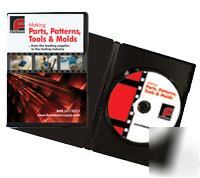EXCLUSIVE FORUM FOR MACHINE DISMANTLERS AND REPAIR PEOPLE > Merrillville
> Heavy Machinery
> Electrical
> AC Single Phase
> 240v
> Dvd: making parts, patterns, tools, & molds
Dvd: making parts, patterns, tools, & molds
Making Parts. Patterns, Tools, & Molds - Fourth Edition
(Total Length: Over 2 1/2 hours)
This listing is for a compilation DVD video that offers a comprehensive introduction into working with plastics (urethanes & epoxies), waxes, and silicone rubber with a new section on advanced fiberglass laminates and vacuum bagging carbon fiber parts. This fourth edition video is the most comprehensive instructional resource for beginners and advanced moldmakers available anywhere for such a reasonable price.
(discount applies only to US & Canada)
Contents of Part I: The Basics:
An introduction making parts, patterns, tools, & molds. Covering the essentials of casting and laminating, this video introduces many of the videos on this DVD and puts it all in perspective.
We briefly demonstrate how master models are created, with special attention paid to CNC machining, from CAD software to the finishing machining pass.
We demonstrate proper procedures for sealing your model or mold and then applying release agents to allow for easy and clean part release.
Weighing & Mixing Liquid Tooling Materials
We demonstrate proper agitating, weighing, and mixing procedures. Both 1:1 ratio and uneven ratio materials are covered.
Vacuum Degassing & Pressurizing
We demonstrate the use of vacuum degassing equipment and pressure pots in order to achieve virtually perfect, void-free castings.
Contents of Part II: Casting Videos
Making Rigid Molds With Fast-Cast Urethanes
Ideal for smaller models/molds with a flat side, fast-cast urethanes are widely used for their ease of use, low cost, and quick demold times. However, their use requires careful application of release agents.
Urethane Rubber molds are widely used when a flexible mold material is required and a more expensive or less abrasion-resistant silicone rubber is not desired. However, their use requires careful application of release agents.
Mass Casting Simple Parts (no parting line)
Ideal for smaller projects (less than 12" x 12"), this is the easiest process for creating parts, patterns, tools, & molds. We demonstrate creating a silicone rubber mold and then the casting of parts with Repro, epoxy casting resins and polyurethane elastomers.
Mass Casting Complex Parts (with a parting line)
When mass casting a part without a flat side, you must create a two-part mold. We create a two-part silicone rubber mold with a clean parting line and then cast the part with Repro.
Moldmaking With Clear Silicone Rubber
When a project requires a complex parting line, it is often easier to pour the entire mold in one process with clear rubber, then cut your parting line. This process also saves at least a day in creating the mold.
When a project requires numerous duplications, a multiple cavity mold is created, enabling many more duplications to be created in a set amount of time.
Casting thin-walled parts follows a similar process to the complex mass casting video above. However, this project requires important differences in venting, gating, and the use of pressure.
Ideal for working on medium-sized projects, this process of pouring a high quality material around a lower quality core creates a highly accurate, yet economical part.
Contents of Part III: Laminating Videos:
Introduction to Epoxy Laminating Systems
Ideal for working on larger projects, a typical 'fiberglass layup' is a popular process for those who need a large, strong, and lightweight tool.
Building a Fiberglass Laminate Mold
New for Fourth Edition!! Here we apply the techniques from the video above plus some more advanced techniques to create a more complex epoxy fiberglass laminate tool.
Vacuum Bagging a Composite Part
New for Fourth Edition!! Using the fiberglass mold created above, we demonstrate the vacuum bagging process by forming a carbon fiber part.
Ideal for working on medium and large projects, this process invloves creating a thin layer of flexible material and backing it up with a stronger, rigid material.
This process is for working on medium to large projects, this is a labor-saving process for those who need a large, strong tool in the least amount of time possible. This video also demonstrates three-part mold construction.
Ideal for working on medium-sized projects, this process is easier, faster, and more economical than the epoxy laminating system.
Contents of Part IV: Product Videos:
This video also includes over 40 minutes of product demonstrations covering:
* Filled and unfilled polyurethane systems
* Addition cure and condensation cure silicone rubber
* Urethane and silicone rubber cure inhibition
* Machinable wax & Sheet Wax
* Modeling boards and tooling boards

